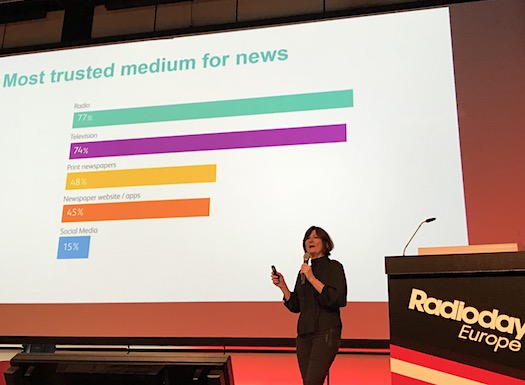A range of speakers at RadioDays have shared their thoughts about how radio can combat the growth of digital competitors.
There were no big new ideas, but there were plenty of smaller ideas and strategies that are being used around the world where radio is pushing itself into the digital realm, to make sure that the medium is not overlooked in the new digital media landscape.
One of the most important reminders came from the UK Radio Centre’s Siobhan Kenny (pictured), who quoted British research showing that Radio is the most trusted medium for news (77%), followed by Television (74%), Print newspapers (48%), Newspaper websites (45%) and finally social media well behind in the trust staked on 15%. So while many people may use social media, they don’t trust it much when it comes to news.
German broadcaster Antenne Bayern personalises the first moments of audio when people request their streams on Alexa and Google Home. Voices of the station’s trusted presenters are heard for a few seconds before the listener joins the stream.
“The presenters give the listener a personal welcome for the first few seconds as they activate our stream on Alexa, it has been very successful in reinforcing the personal link we have with our listeners and bringing it onto these new platforms.”
Caroline Graze Managing Director Radioplayer Germany says radio networks need to collaborate in order to face the digital giants.
“Accessibility is all that matters, we want people to find radio accessible, easy to use. Audio consumers don’t need to own their songs or recordings any more, they are happy to rent them, they may not bother to own radios either, but if they can ‘rent’ our streams, podcasts and other content then they will approach radio in the same new way as they do their other audio choices.”
The new Audi has seven antennas built into the car. “The experience is not just about driving, it is about making the driver feel welcome in the car without having to worry about where the signal is coming from. It just has to work.” (see related report)
Robert Foster from Multicast Media talked about the importance of visualising radio. He advised broadcasters to make sure their station has video content that emerges from the audio content so that it can be placed on social media.
Looking at audience research, a chart was presented that showed the usual ratings trend we all know about, where there is a spike at breakfast, a dip during the day and a lesser spike at drive which declines into the evening. That chart was overlaid with the trends for podcast listening, which filled in the places where traditional radio listening dipped. The point was that podcasting can extend radio’s reach at times when traditional listening to a transmitter is uncommon or inconvenient. “Audio is the whole day on,” concluded the German researcher.
Another speaker made the point that one of the biggest audio channels is YouTube. Many people listen to songs and interviews on Youtube, with our without pictures. Radio stations should make sure they have some kind of visual and/or audio presence on YouTube to be where the audience is.
One of the problems for radio on the internet is that the internet is text based, it is difficult to search and find audio. Audio transcription and enriched audio content are growing trends which broadcasters are using to make their audio more searchable and findable on then internet. “Audio is being transcribed and timestamped to generate ‘context linking,’ which optimises audio for searchability.”
An important development to help searchability of audio is a new innovation in RCS Zetta's new transcript function. It can be used in metadata and AI systems to help audio searchability according to RCS' Philippe Generali.
Audio consumers are creating their own ‘micromoments’ by combining the segments they like from many radio stations. More and more listeners are creating their own playlists of favourite radio segments.

